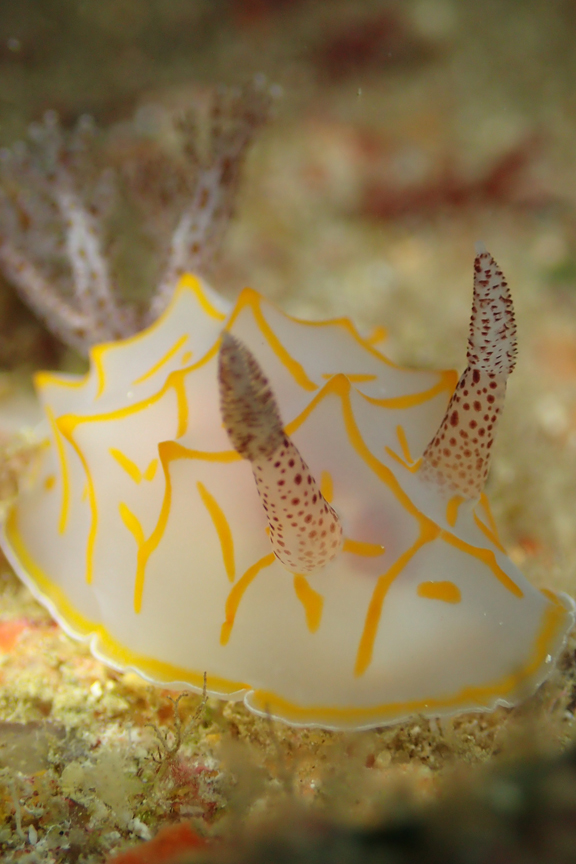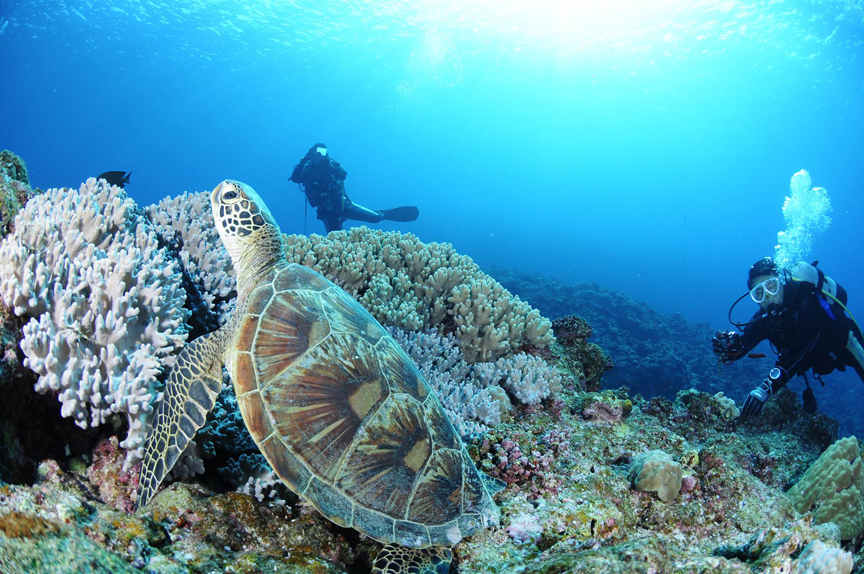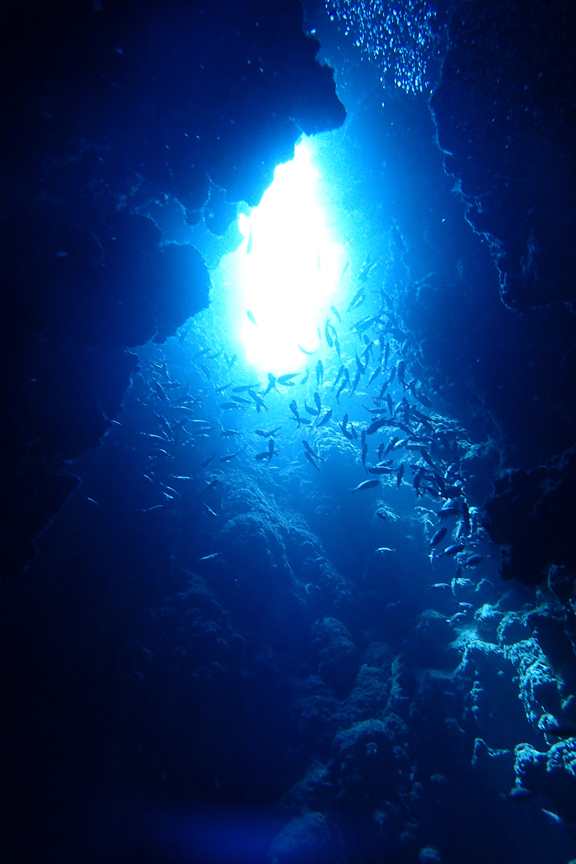Below the ocean surface lies a landscape littered with patches of coral reef, sandy areas and nudibranchs that light up against torches. Huge rocky structures with tunnels and arches plummet into the depths, the sunbeams streaming through them. Bonnie Waycott dives into a world of colorful marine life and limestone as she visits Okinawa’s Miyakojima.

Many moons ago, the ocean worked its magic on Miyakojima, creating a haven of tunnels, arches and swim-throughs. During the summer, divers come to the island in droves for a glimpse of these limestone formations.
It is 300 kilometers southwest of Okinawa’s main island, and diving off Miyakojima is a journey into a world of colossal structures, a series of rocky outcrops and winding horizontal tunnels that open onto sandy areas or smaller coral reefs. Inhabited by some of the area’s most vibrant creatures, the mixture of underwater topography, blue water and colorful reefs are a viable alternative to some of Okinawa’s busier locations.
Nakanoshima Channel
With a 14-meter deep seabed and a collection of medium-sized boulders to start the dive, Nakanoshima Channel is ideal for spotting all manner of marine life. A narrow arch takes you down to around 18 meters, where it’s clear this is a haven for a good range of fish and other critters.
Around the rocky structures are schools of red soldier fish with huge black eyes, juvenile bi-color parrotfishes hovering gently close by and, as the seabed is sandy, it’s possible to lie on the sand and watch tiny jawfish peering out from their lairs, waiting patiently for divers to move on or immediately disappearing if so inclined.
This dive has a maximum depth of around 20 meters and offers a leisurely drift over a few sandy areas interspersed between rocky structures. Close by is the entrance to a small tunnel with promises of close encounters with a variety of smaller critters.
Don’t forget to use a flashlight when examining the rocky walls for vibrant sponges, corals, fans and even some urchins. More observant divers will notice the odd leaf scorpion fish or two tucked into the holes and hollows. As the dive draws to a close, a tiny bit of surge spits divers out of the tunnel to the other side, marking the start of a fun ascent with a range of colorful nudibranchs sticking to their rocky homes.
Hon Drop
As its name suggests, this site is a daunting drop-off that rises from 35 meters to a plateau at eight meters. The dive begins down the wall to about 12 meters, where schools of reef fish mill around in the shallows, but the pièce de résistance is a giant trevally that takes refuge in the rocky gullies and overhangs.
When taking photos here, timing is crucial, as the giant trevally is gentle and shy, quickly moving away and out of sight with a flick of its tail. On good days it’s possible to see three or four, but most divers are more than happy with just one.
The current at this site can sometimes be mild, but this brings a range of fish to the area, while the sun bathes the area with prism-like ripples of light that skip across the rocks. This is a great site to cruise over a diverse range of marine life—it’s the perfect site and amphitheater for curly anemones that house a variety of clownfish as well as the odd black-spotted pufferfish seen finning away.
Other patches close by provide some of the area’s brightest sponges and nudibranchs. The fish life here may be less abundant, but the huge rocky structures keep divers entertained. It’s also a good spot to enjoy relaxing macro photography.
Mini Grotto

Mini Grotto is the perfect place to experience Miyakojima’s rocky structures and tunnels in all their glory. While the miniature life is outstanding here, most divers visit for the tunnels, rocks and swim-throughs. A sloping seabed covered with boulders leads toward the deeper depths while turtles graze close by, unfazed by their audience and enjoying a meal off the rocky patches.
At around 15 meters is a small tunnel where divers penetrate the darkness, flashlights in hand. It’s worth taking time to look at the proliferation of nudibranchs that have made this area home. Soon the swim feels like an ascent as the surface of the water approaches with the sun streaming into the exit route, creating a spectacular scene. An eerie, blue glow in the distance gets brighter and, popping up above the water and breathing in the fresh sea air, it’s possible to rest awhile in a small pool of crystal clear water and marvel at the colossal rocky structures all around.
The return journey starts here via the same tunnel, descending once more into the depths, so divers visiting this site must have good ear-clearing skills. It may be dark and gloomy, but the diving doesn’t get much better. Soon, shoals of chromis appear in the shallows, feeding on drifting plankton, while free-swimming stout chromis and red snapper pass slowly by.
Mao no Kyuden

Jump off the boat here, and a scene of boulders and overheads unfolds, followed by a labyrinth of tunnels. With just a few more fin kicks, more walls and rock formations. An air of mystery and anticipation fills the scene at Mao no Kyuden where several large chambers and tunnels appear linked together.
Although an opening is never far away, it’s not hard to lose one’s bearings, making navigation here slightly difficult (don’t lose sight of your guide). The site’s deeper spots (around 25-27 meters) make it more suitable for advanced divers, while those who may be claustrophobic might want to avoid the narrower tunnels altogether.
Dropping down to about five meters, a gentle slope leads to a wall at around 18 meters. Shoaling large-scale soldier fish are everywhere, while schools of sweepers swim in and out, joined by a few other species.
The highlight of this site, however, is a tiny resident candy crab at around 21 meters. Wrapped around a piece of soft coral and wary of the flashlights around him, he lights up in shades of beige and pink.
Next to the candy crab’s home is an entrance up a long straight tunnel through a velvety blackness. Soon the tunnel’s immense beauty reveals itself as the sun penetrates through, highlighting filefish and sweepers competing with each other for space, as well as an abundance of schooling fish.
A wonderland of vibrant marine life adorns the famous limestone structures of Miyakojima’s unique ecosystem. This stunning underwater landscape, combined with a wide range of fish and tiny critters inhabiting the waters, makes for magical recreational diving and heaven for underwater photographers.
PRACTICALITIES
- Getting There: Direct flights are available from Tokyo’s Haneda Airport (2 ½ to 3 hours).
- Getting Around: Hiring a car is the best way to explore Miyakojima. Most rental firms have an outlet at Miyako Airport, and driving on the island is easy and enjoyable. Bicycles and scooters are also available for rent.
- Climate: Mild and sometimes rainy winters and hot summers. Average temperature is around 24 C with the highest average around 32 C in summer.
- Water Temperature: This varies between 22-23 C in the winter to 28-33 C in the summer. A 5-mm wetsuit is best during the summer but a 7-mm or something warmer for the winter should work well.
- Accommodation: This varies greatly from modest pensions and traditional Japanese inns (minshuku) to western-style business hotels and resorts that are a little bit more expensive.
- Additional Info: The two main dive shops on the island are Dive Kids and Kara Kara Sensei Diving. Kara Kara Sensei Diving can arrange diving and accommodation packages.
- Please note Dive Kids and Kara Kara Sensei Diving don’t speak much English and can only answer basic English e-mail inquiries.
- If you don’t speak Japanese and want to dive off Miyakojima, Bonnie is happy to provide information about travel details.
- E-mail bonniewaycott@gmail.com or visit the Rising Bubbles Facebook Page.




